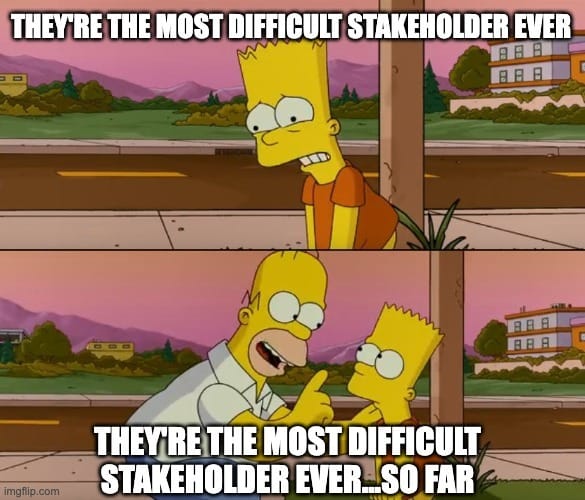- SalesforceChaCha
- Posts
- 💃 3 Surprising Ways to Handle Difficult Stakeholders🕺
💃 3 Surprising Ways to Handle Difficult Stakeholders🕺
Does not include deleting their Salesforce user...
Good morning, Salesforce Nerd! Does this hit a nerve-
🥵 The VP of Marketing who blames their bad marketing results on Salesforce.
🥵 The Regional Sales Manager who starts every meeting with finger-pointing the CRM for user-caused issues.
🥵 The client who is way over hours but is taking advantage of a bad SOW.
What if you had a toolbox 🧰 to deal with difficult stakeholders?
Here are 3 techniques you can use to turn the tides 🌊

DEATH BY NICE
Kill ‘em With Kindness
Difficult stakeholders aren’t villains 🙅.
They’re scared 😱.
Scared of losing control, missing KPIs, or looking bad in front of leadership. Their “difficult” behavior is often anxiety in disguise.
When you meet hostility with kindness - calm tone ☺️, curiosity 🤔, and genuine kindness 🤗 - you disarm their defensiveness. Suddenly, the friction turns into fellowship 🙌.
I worked with client’s marketing leader who was frustrated by Pardot’s (aka Marketing Cloud Account Engagement) limited functionality. While their rage was rooted in Pardot’s shortcomings, it was taken out on me and the project team.
After a few weeks of angry outbursts - “why can’t Pardot do what we need? Then we’d be able to this and do that!” - I went from ignoring the negativity to pointing out the incredible knowledge they displayed. The “this” and “that” were solid tactics, and I agreed with them “you’re totally right! That would be super valuable, that’s such a good insight!”
That response was greeted with emphatic “yes!” and all of a sudden we were aligned, not fighting! A switch had been flipped 💡!
Kindness is like a Flow, one trigger can set off a cascade of positive actions. Respond to anger with empathy, and you transform an escalation into collaboration.
💥 Pro tip: Don’t mirror their energy, mirror their intent. If they’re frustrated about reports, they probably care about visibility, not visuals. Solve for the intent, not the tone.
GIVE EM SHINE
Give Credit Where It’s (Not) Due
You don’t lose power by sharing it.
Here’s the paradox: the harder someone is to please, the faster they melt when you make them the hero 🫡.
Most stakeholders operate in competitive environments. They’re juggling expectations, managing visibility, and trying to prove they’re valuable. When you publicly give them credit for progress, whether they deserve it or not 🤷🏻, they go from combative to cooperative.
That marketing leader who hated Pardot? Our senior developer worked overtime to build workarounds and get them close to where they wanted. And when the work was done and the solution was humming, we gave the marketing leader ALL THE CREDIT 😀.
And why not - marketing is their space, not the project team’s. Most importantly, the shine we gave them completely changed their respect for the project team (and a little bit for Pardot 😘). Meetings became focused on ideation and execution, and lost the negative edge of anger and blame.
Yes, it feels counterintuitive, but here’s the thing- when you stop caring about who gets the applause 👏, you suddenly have all the influence 💪.
💥 Try this: In your next demo, highlight one stakeholder’s idea. Even if it was a minor comment. You’ll be amazed how fast they transform from skeptic to supporter.
INCENTIVES INCENTIVES INCENTIVES
Understand Their Incentives
“Show me the incentive, and I will show you the outcome.” - Charlie Munger
Everyone has an incentive, even your most difficult stakeholders. It’s your job to figure out what is driving them 🤔.
Ask yourself-
🤔 What are they being measured on?
🤔 Who are they trying to impress?
🤔 What do they fear losing control of?
When you understand those levers, you can do Salesforce things that align with their world and influence them to bend to your will.
One example is incentivizing your boss to send you to Dreamforce. Salesforce provides a pre-baked letter full of incentives, including delivering better ROI to customer and clients, AI workshops to bring back to the company, and stats that show positive return for attendees.
You can also disincentivize a bad decision. For example, a VP of Sales who insists on changing the Opportunity stages….again…to encourage more aggressive closes is actually slowing the sales cycle down because the salespeople need re-training on what each status means, the validation rules to progress, and the automation that kicks off.
As Charlie Munger said, “…if you want ants, put sugar on the floor.”
If you want something, understand the incentives that will manifest it 🪄.
FINAL THOUGHTS
Takeaway
Now you have a toolbox for dealing with difficult stakeholders 🙌.
They’re no longer your enemy. Now they’re a bomb to be disarmed with kindness, a weathered surface that needs a little shine ✨, and a block of clay to be molded and influenced by incentives .
🤗 Kindness disarms.
🤝 Credit builds allies.
🤲 Understanding incentives creates alignment.
That’s the trifecta.
As a Salesforce professional, you’re basically a professional problem solver. Tough stakeholders are just another problem to solve!
SOUL FOOD
Today’s Principle
"Every strike brings me closer to the next home run." - Babe Ruth
and now....Your Salesforce Memes



What did you think about today's newsletter? |